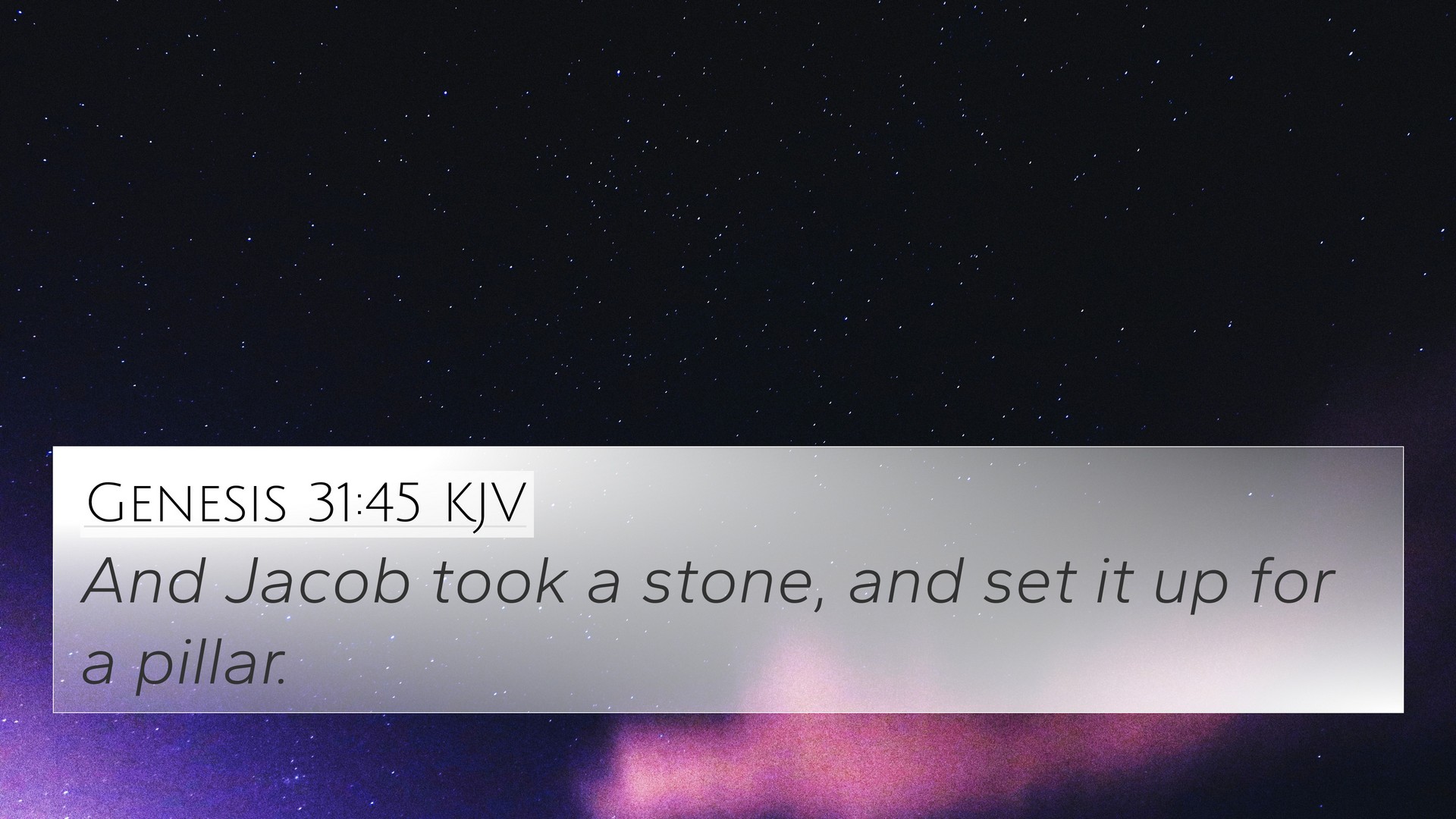Understanding Genesis 31:45
Genesis 31:45 states, "And Jacob took a stone, and set it up for a pillar." This verse appears during a crucial moment in Jacob’s journey, marking a significant decision in his life and his relationship with Laban. This commentary aims to explore the meaning of this verse by drawing insights from Matthew Henry, Albert Barnes, and Adam Clarke.
Contextual Overview
In Genesis 31, Jacob is leaving Laban’s house after years of service. Tensions have grown between Jacob and Laban, leading to this pivotal decision to depart. The act of setting up a stone pillar symbolizes the covenant and the boundary between Jacob and Laban, indicating a formal agreement to ensure peaceful coexistence.
Commentary Insights
-
Matthew Henry:
Henry emphasizes the significance of Jacob's actions, viewing the stone as a mark of remembrance. He interprets this act as Jacob's way of establishing a testimony to God’s faithfulness amid his trials. Setting up the stone also symbolizes Jacob's desire to acknowledge God’s protection and guidance throughout his journey.
-
Albert Barnes:
Barnes notes that the stone not only signifies a boundary but also symbolizes Jacob’s resolve and determination to separate himself from Laban’s influence. It serves as a memorial of the covenant made, showing the importance of physical reminders of spiritual commitments.
-
Adam Clarke:
Clarke adds that the stone represents a witness to both parties. Whether interpreted as a pillar of abandonment or one of agreement, the stone's placement marks a transition in Jacob's life, one that was essential for his future. Clarke also connects this act to other biblical events where stones represented memorials and covenants.
Thematic Connections
The act of setting up a pillar is not isolated in the Scriptures; it resonates with other themes and events in the Bible. This verse can be cross-referenced with:
-
Exodus 24:4: "And Moses wrote all the words of the Lord… and built an altar under the hill, and twelve pillars, according to the twelve tribes of Israel," signifying commitments made to God.
-
Joshua 4:20-24: "And those twelve stones, which they took out of Jordan, did Joshua pitch in Gilgal," establishing a reminder of God’s miraculous deeds in Israel's history.
-
1 Samuel 7:12: "Then Samuel took a stone, and set it between Mizpeh and Shen, and called the name of it Ebenezer, saying, Hitherto hath the Lord helped us," concluding a spiritual journey with a physical marker.
-
Genesis 28:18: "And Jacob rose up early in the morning, and took the stone that he had put for his pillows, and set it up for a pillar, and poured oil upon the top of it," linking Jacob's earlier experiences with stones as a sacred symbol.
-
Genesis 35:14: "And Jacob set up a pillar in the place where he talked with him, even a pillar of stone," reiterating the importance of physical reminders in one's spiritual journey.
-
John 4:20-24: Illustrating the importance of worship and remembrance in a spiritual context, paralleling Jacob's need for commitment through physical acts.
-
Hebrews 11:21: "By faith Jacob, when he was a dying, blessed both the sons of Joseph, and worshipped, leaning upon the top of his staff," highlighting the importance of remembrance and dedication in faith.
Conclusion
Genesis 31:45 encapsulates a moment of transition and commitment in Jacob's life. Through the lens of these commentaries and cross-referenced verses, the act of erecting a stone pillar emerges as a rich symbol of faith, memory, and divine guidance. Understanding this verse, along with its thematic connections, enriches our interpretations and strengthens our grasp of the narrative's ongoing dialog in scripture. For those delving into Bible verse interpretations, tools for Bible cross-referencing can greatly enhance understanding, revealing deeper layers of meaning within the text.



